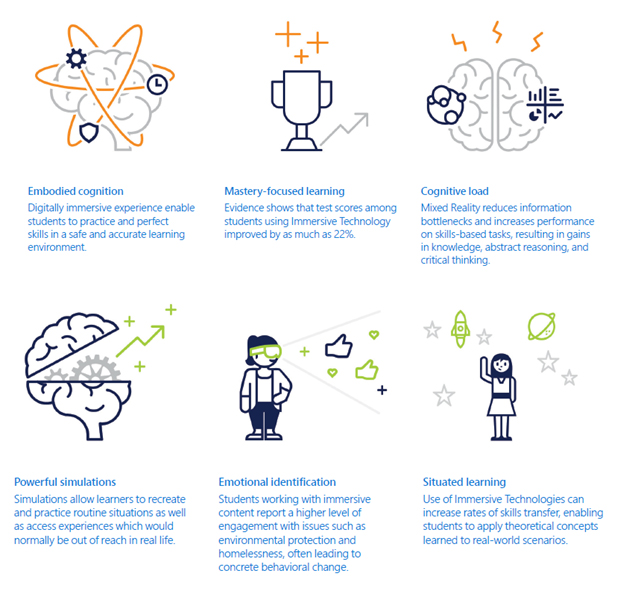
Reap the Maximum Benefits of Power BI with Microsoft Dynamics 365 Suite of Products
Microsoft Power BI with Dynamics 365 products can provide valuable data insights and support for your sales team to make informed decisions.

#FocusOnBestLearningExperience
Microsoft Stated that Immersive technologies are becoming more popular and accessible to consumers, and this means that they are starting to see their use in a wider variety of settings, including the campus classroom. This is a positive development for teachers and students alike with Dynamics 365 business central implementations. When immersive technologies and game-based learning are deployed correctly and in a pedagogically consistent manner, they have the potential to support and expand curriculum, enhancing learning outcomes in ways which haven’t been previously possible, affordable, or scalable.
In the field of EdTech, technology often tends to take precedence over education, meaning that management solutions are implemented without appropriate consideration and scrutiny of the pedagogical context within which they will be applied. This leads to the failure of many initiatives, because regardless of the transformative power of any one technology, its effectiveness inherently depends on coherent deployment as part of a broader strategy. This is evident in the education sphere in particular, where success is invariably linked to effective engagement with educators, and to building responsive feedback loops that prioritize learning outcomes. To ensure personalized learning and social and emotional skills; mixed reality tools, collaborative platforms, campus management solutions and AI-enabled analytics immersive experiences play a critical role in modern education.
As immersive technologies evolve, a more complex and granular picture emerges. There is an entire spectrum where the digital and real worlds mix together, giving rise to the term Mixed Reality, which is increasingly gaining traction. It offers extraordinary opportunities for enhancing motivation and learning across a range of subject areas, student developmental levels, and educational settings. Virtual Reality (VR) is often used to refer to enclosed experiences that fully immerse the user in a computer generated environment and shut out their physical, surroundings to a large degree. Augmented Reality (AR), experiences, in contrast, superimpose digital elements onto real-world objects and backdrops.
Immersive technologies, such as NAV and MR, can impact learning outcomes—for example, reducing the cognitive load on the brain by allowing direct, first-person visualization of complex ideas and structures. This not only dramatically increases student engagement, but also enables learners to assimilate complex information more efficiently and retain it for longer.
Psychological immersion: Although it may seem counter-intuitive, basic ideas and skills are best learned in the context of attempting relatively complicated tasks that have relevance to the real world.5 This occurs because both the configuration and the coordinated team activities within this environment provide a wealth of embedded knowledge.
Narrative and symbolic immersion: Narrative is an important motivational and intellectual component of all forms of learning, and an immersive experience can trigger powerful semantic associations. In a mediated, simulated experience, immersion requires the willing suspension of disbelief which is prompted by emotional investment in a compelling narrative. Inducing powerful immersion for learning therefore depends on designs that utilize actional, social, and symbolic/narrative factors.
The jobs that will be available in the next few decades will require high levels of collaboration, negotiation, and emotional intelligence—while putting a premium NAV solution in action.
Dynamics 365 business central helps you focus on skills such as deeper cognitive abilities, creativity, and critical thinking. These cognitive skills are currently where the vast majority of the evidence base for MR in education shows significant promise. There are certain cognitive factors triggered by immersive technologies which are particularly relevant in a learning content.

Although the cost of hardware and implementation might currently present a barrier to some educators looking to adopt immersive technologies in their campus, as such costs inevitably decrease this technology has the potential to become a hugely democratizing force in education, allowing students from all backgrounds to gain access to experiences which might have been previously outside their reach. One way this can be achieved is in providing students with virtual field trips. Immersive technologies can provide settings in which students can work collaboratively and have the potential to enable broader and more egalitarian access to knowledge. Learning experiences can also be more personalized to suit students whose previous attitude toward learning had been negative.
The Korcomptenz Campus Management Solution built on Microsoft Dynamics NAV and Dynamics 365 Business Central covers all workflows related to education such as Admission, Academics, Fee Management, Library, Timetable, Alumni, Hostel Management and Fleet. With the advent of Digitalization, more and more institutions are storing their data in the cloud. To best leverage the benefits of the Cloud, Microsoft Dynamics 365 has provided a host of cloud-based solutions and services tailored for the Education Industry. Microsoft offers many productivity and collaboration tools that allow teachers and students to improve creativity, communication, and collaboration.

Microsoft Power BI with Dynamics 365 products can provide valuable data insights and support for your sales team to make informed decisions.

Find out about the top ERP trends to get your organization ahead in 2023 and after. The trend is towards emerging technologies and concepts like composable ERP solutions.

Non-profits strongly depend on donations and grants and are accountable when it comes to their funds reporting and spending.
| Cookie | Duration | Description |
|---|---|---|
| cookielawinfo-checkbox-analytics | 11 months | This cookie is set by GDPR Cookie Consent plugin. The cookie is used to store the user consent for the cookies in the category "Analytics". |
| cookielawinfo-checkbox-functional | 11 months | The cookie is set by GDPR cookie consent to record the user consent for the cookies in the category "Functional". |
| cookielawinfo-checkbox-necessary | 11 months | This cookie is set by GDPR Cookie Consent plugin. The cookies is used to store the user consent for the cookies in the category "Necessary". |
| cookielawinfo-checkbox-others | 11 months | This cookie is set by GDPR Cookie Consent plugin. The cookie is used to store the user consent for the cookies in the category "Other. |
| cookielawinfo-checkbox-performance | 11 months | This cookie is set by GDPR Cookie Consent plugin. The cookie is used to store the user consent for the cookies in the category "Performance". |
| viewed_cookie_policy | 11 months | The cookie is set by the GDPR Cookie Consent plugin and is used to store whether or not user has consented to the use of cookies. It does not store any personal data. |